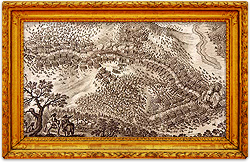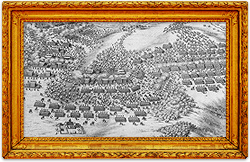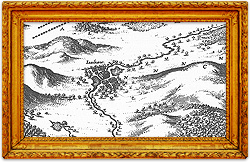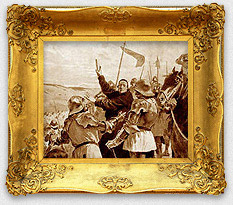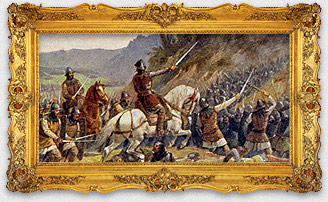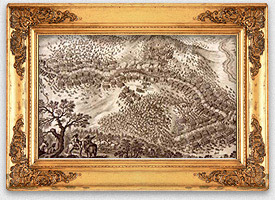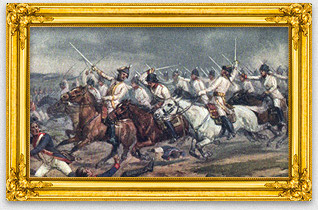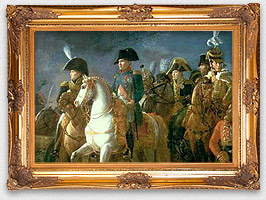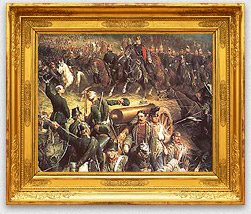Historical Context
In years 1618 – 1648 a conflict took over the whole area of Europe which entered the history as the Thirty Years’ War. The conflict was a culmination of long-lasting religious-power disputes between the lands of the Catholic and Protestant camps. With the throwing out of the Imperial vicegerents from the windows of Prague Castle on 23rd May 1618 the first phase of the Thirty Years’ War, called Bohemian War (1618 – 1620).
The first period came to its end by the defeat of the Bohemian non-Catholic estates in the Battle of White Mountain on th November 1620. Other military operations took place on the area of Germany in the regions of Upper and Lower Pfalz and from the military point of view we speak of so called Pfalz War (1620 – 1623). In the third phase of the conflict the lead of the opposition against the Habsburgs was taken by Denmark and this period is called Danish War (1625 – 1629). In 1630 a new coalition against the Habsburgs is founded and in its lead there is the Swedish king Gustav II Adolf and the fourth phase the fighting is called Swedish War (1630 – 1635).
The last period of the Thirty Years’ War was took place in 1635 – 1648. The coalition against the Habsburgs was joined by France led by Cardinal Richelieu and this phase is, according to the newly concluded alliance between Sweden and France, called Swedish-French War.
During the final period of the war the Bohemian Lands became again the site of the military operations. On 6th March 1645 the Swedish and Imperial armies clashed in one of the bloodiest battles of the whole Thirty Year’s War, in the Battle of Jankau.
Preceding Events
During 1644 in Münster and Osnabrück the peaceful negotiations were initiated in which the Swedish Kingdom tried to gain as many advantages as possible before the final conclusion of the definite peace. That is why in late January 1645 the Swedish army led by Marshal Lenhart Torstensson entered again the Bohemian Lands. The Swedish commander intended to join the troops of Prince of Transylvania George Rákoczi and to endanger directly Imperial Vienna.
In early February 1645 the Torstensson’s army reached the city of Kadaň and they proceeded further across Western Bohemia towards the inland. Slow movement of the Norther army enabled the Emperor Ferdinand III to gather enough military power, led by the Marshal Melchior von Hatzfeld. The Imperial army was further strengthened by the helping Bavarian force of the General Werth and from Hungary by the quickly called troops of the Marshal Götz.
Both belligerent armies clashed at each other for the first time on 26th February near Horažďovice where they were separated from a direct confrontation by the Otava River. Neither of the parties wanted to risk a difficult crossing of the river and the Swedish army, gradually manoeuvring, started to move further to the East. On 2nd March the Torstensson’s troops crossed successfully the Vltava River not far from Orlík Castle and continued towards the North-East. The Imperial managed to overtake them thanks to a fast march the advancement of their enemy and the Marshal Melchior von Hatzfeld decided to block the enemy’s way to Moravia not far from the village of Jankau, approximately on the half way between Votice and Louňovice pod Blaníkem.
Course of the Battle of Jankau
On 6th May 1945 in the morning hours the Battle of Jankau took place. During the previous day the marshal Tortensson thoroughly reconnoitred the terrain and instead of the tactics of frontal clash of two lines he decided to attack the left wing of Hatzfeld’s armyfrom its side across the frozen ponds. The commander of the left wing of the Habsburg army, marshal Götz had an impetuous reaction to the Swedish movement and without any proper reconnaissance of the terrain he started his attack with his cavalry in a narrow space surrounded by dense forest and ponds. Nine of Götz’s cuirassier troops got hopelessly stuck in a hardly accessible terrain gorge and were decimated by heavy firing of the enemy artillery. The following Swedish counterattack finished the destruction of Götz’s troop and the marshal himself died in the fight.
The right wing of the Imperial army which was commanded by the general Johann von Werth tried to go around the impassable forest, they however, also ended in heavy firing of the Swedish artillery and was forced to withdraw.
During the midday the situation on the battle field of Jankau was getting really critical for the Imperial army. The Imperial troops were withdrawing along the whole line, the Hatzfeld’s troops, however, managed to rearrange themselves and to stop the Swedish attack. Habsburg marshal sent into the fight the Bavarian cavalry which together with a part of the foot troop attacked the left Swedish wing.
In the heavy fight several Imperial troops managed to go around the enemy positions and to get to the Swedish rear. However, instead of attacking Torstensson’s troops the soldiers started to plunder the enemy’s camp. The Imperial officers were not able to force the plundering mercenaries to further fighting which gave the marshal the necessary time so that he was able to rearrange his troops against the plundering soldiers and with a fast counterattack he got back the terrain.
The following frontal attack forced the rest of the Imperial troop to flee definitely from the battle field. The Battle of Jankau ended with an absolute victory of the Swedish army.
Result
The Marshal Torstennsson achieved a crushing victory over the Imperial army in the Battle of Jankau. The Habsburger army lost almost 4,000 men, including the Marshal Götz. Nearly the same number of the soldiers were captured by Swedes, including the Marshal Hatzfeld and five other generals. The General Johann de Werth fled with the rest of the Bavarian troops via Tabor towards Bavaria. The Emperor Ferdinand III, who was staying in Prague in that time, was forced, under the pressure of the events, to leave the city and move quickly to Austria.
Historical Importance
The victory in the Battle of Jankau enabled Swedes to continue in their campaign to Moravia. There was only one last obstacle, the city of Brno. The more than three months lasting unsuccessful siege of Brno reduced the consequences of the Jankau defeat and did not let Torstensson to bring his military campaign successfully to its end. The Emperor Ferdinand III gained the necessary time to form new military troops and saved Vienna from imminent Swedish siege.
Author: Mgr. Petr Kovář



